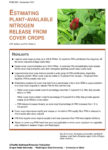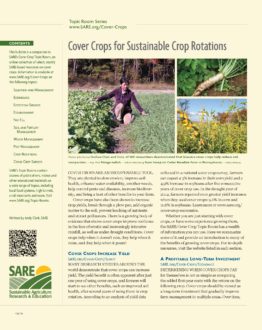From cycling nutrients to reducing erosion to breaking compaction, cover crops offer a host of benefits to soil and fertility.

Building Soils for Better Crops
Building Soils for Better Crops is a one-of-a-kind, practical guide to ecological soil management, now expanded and in full color.Download File (6.76 MB) | Online Text Version

What is Soil Health
Soil health plays an essential role in raising healthy, productive crops and livestock. With this interactive infographic, learn how practices such as cover crops, no-till, crop rotation and the integration of livestock work in concert to improve soil health.

10 Ways Cover Crops Enhance Soil Health
Soil health is a hot topic these days, one that is justifiably receiving considerable attention from farmers and their farm advisors. This short fact sheet highlights some of the key ways that cover crops improve soil health by influencing the biological and physical characteristics of the soil.Download File (608.79 kB)
Organic Fertilizer and Cover Crop Calculator
This free online tool compares the nutrient value and cost of cover crops, organic and synthetic fertilizers and compost. Use this Excel Calculator to develop well balanced and cost effective nutrient management programs for your farm.

Estimating Plant-Available Nitrogen Release from Cover Crops
This Oregon State University fact sheet explains the basics of plant-available nitrogen (PAN); when to kill cover crops for the maximum PAN benefit; step-by-step instructions on how to perform site-specific measurements to predict PAN from your cover crop; and case studies from the Willamette Valley.

Cover Cropping: On-Farm, Solar-Powered Soil Building
This information sheet gives an overview of how to use cover crops to maintain good levels of nutrients and organic matter in the soil.Download File (213.88 kB)

Cover Crops, Soil Health Principles and Maximizing Yields
Learn about basic soil health principles and how cover crops are key to making those happen on your farm.

Combining Livestock, Manure and Cover Crops
A livestock and cover crop combination is the fastest way to profit from your investment.
Also, visit SARE's database for reports on these research projects:
- Corn Silage Production with Kura Clover Living Mulch and Winter Rye Cover Crop; Soil Erosion, Nutrient Runoff, and Soil Physical Properties (2010, Wisconsin)
- Lighting up the Black Box: Improving Legume Performance on Organic Farms by Optimizing Microbially-Mediated Plant and Soil Nitrogen Cycling Processes (2010, North Carolina)
- Balancing Nitrogen Sinks and Sources Using Cover Crops on Manured Fields (2010, New York)
- Optimization of Corn Production Following Legume Green Manures (2008, Wisconsin)
- Using Oilseed as Biological Plow to Reduce Soil Compaction and Recycle Nutrients (2008, Ohio)
- Learning from Farmer Innovation in N Fixation for Improved Nutrient Management on Organic Farms (2007, New York)
- Managing Soil Food Webs for Enriched and Suppressive Soils: Effects of Cover Crop Diversity and Quality (2007, California)
- Selecting Cover Crops for Diverse Functions: An Integrated Soil Management Approach for Organic Strawberry Production in North Carolina (2007, North Carolina)
- Estimating Nitrogen Contribution from Cover Crops in Organic Vegetable and Cane Berry Farms (2006, Oregon)
- Evaluating Winter Crops for the Environment and for Profit [on dairy farms] (2005, Ohio)
- Multipurpose Brassica Cover Crops for Sustaining Northeast Farmers (2003, Maryland)
- Winter Cover Crops for Corn Production in the Northeast: N Balance and Soil Moisture Status (1989, Maryland)
Dig deeper into cover crops research: SARE has funded hundreds of research and education projects related to cover crops since 1988. This topic room features only a glimpse into SARE's entire portfolio of cover crop research. To discover more, visit SARE's database of projects and conduct full text or advanced keyword searches.
